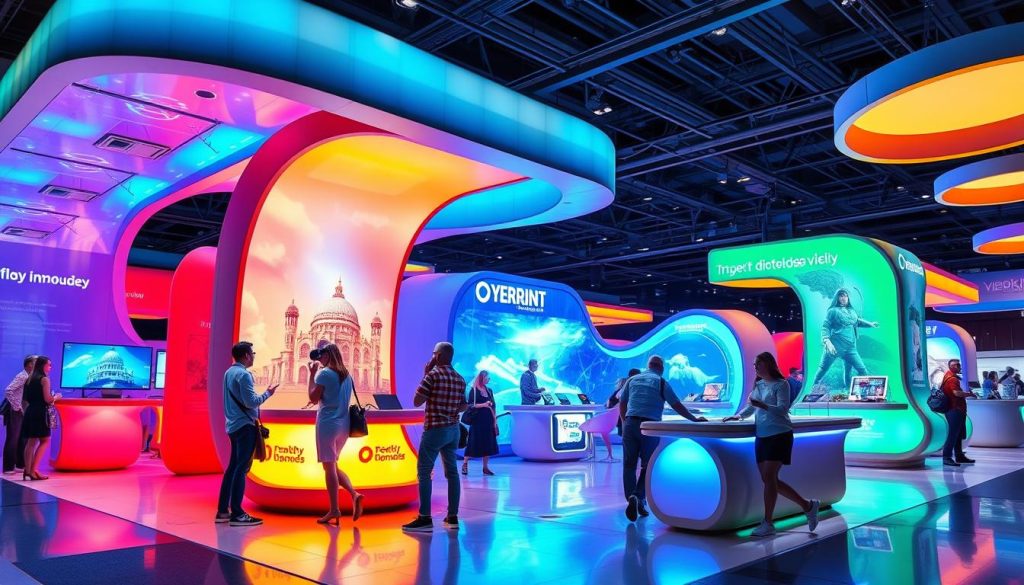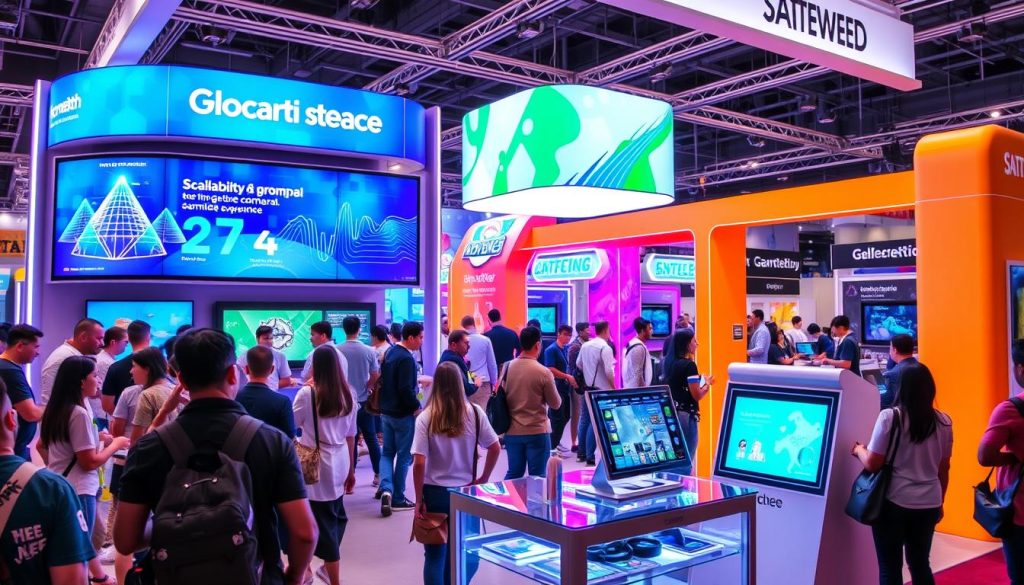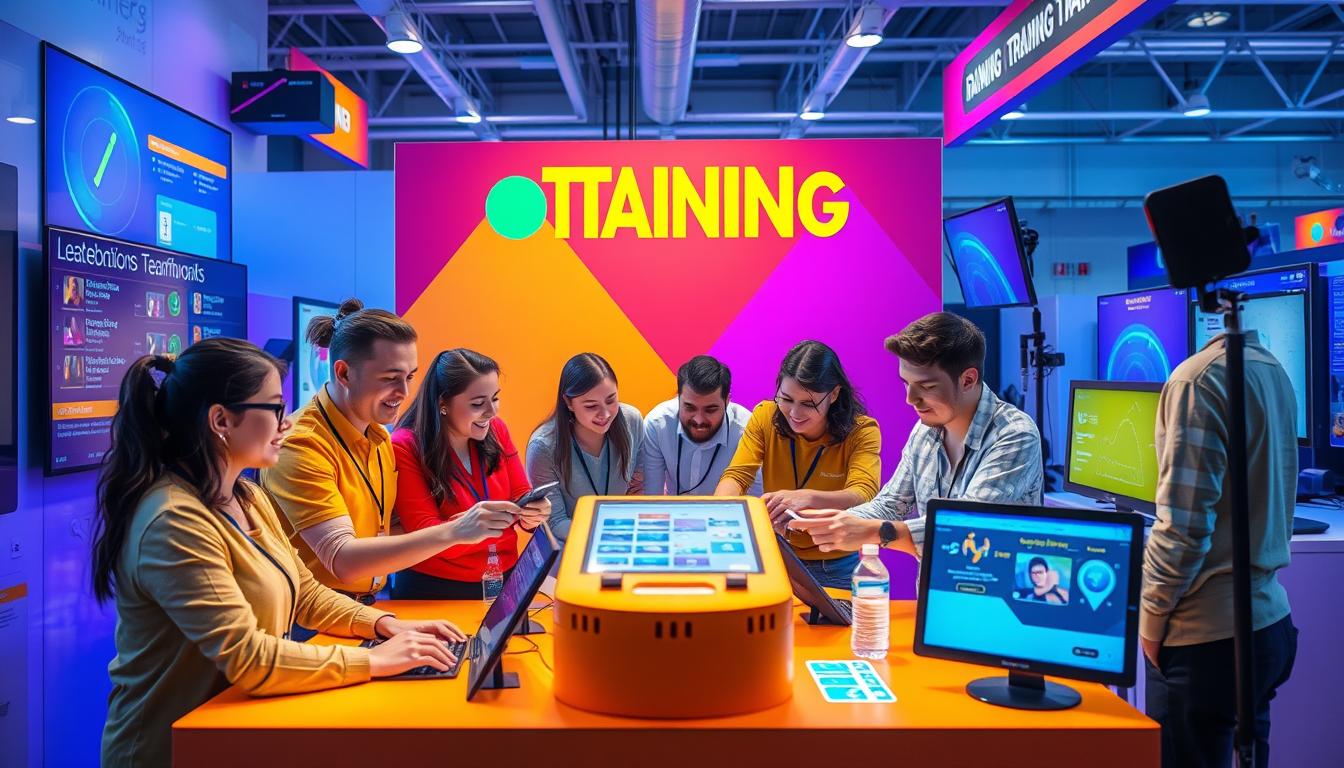Gamification strategies are changing the face of trade shows. Interactive booth design now plays a key role in creating engaging customer experiences. By turning your booth into a fun, game-like space, you can draw in more visitors and leave a lasting impression.
But a great booth is only half the battle. Your team needs to be ready to make the most of these new tools. Training your staff to run a gamified booth is crucial for success. They need to understand how to use the games, interact with visitors, and turn play into real business connections.
With the right training, your team can turn your interactive booth design into a powerhouse of customer engagement. They’ll learn to guide visitors through your games, explain your products, and capture valuable leads. This blend of fun and function is what sets successful trade show booths apart in today’s competitive market.
Key Takeaways
- Gamification boosts visitor engagement at trade shows
- Interactive booth design creates memorable experiences
- Proper team training is essential for gamified booth success
- Staff must understand both game mechanics and product info
- Effective gamification turns play into business opportunities
- Well-trained teams can maximize lead capture through games
Understanding Gamification in Trade Show Environments
Trade show booth gamification has revolutionized how brands engage with attendees. This innovative approach transforms traditional booths into interactive experiences, capturing attention and fostering memorable connections. Let’s explore the key elements that make booth gamification successful and the psychology driving its effectiveness.
Elements of Successful Booth Gamification
Effective trade show booth gamification combines several crucial components:
- Clear objectives aligned with brand goals
- Engaging game mechanics that appeal to the target audience
- Rewards that motivate participation
- Seamless integration of technology
- Measurable outcomes for ROI analysis
These elements work together to create immersive experiences that drive engagement and boost lead generation. Implementing effective CRM strategies can further enhance the impact of gamified marketing campaigns by tracking and nurturing leads post-event.
Psychology Behind Interactive Marketing
The success of audience participation tactics in trade shows stems from fundamental psychological principles:
Gamification taps into our innate desire for achievement, competition, and recognition, making brand interactions more rewarding and memorable.
By leveraging these psychological triggers, brands can create deeper connections with attendees, increasing the likelihood of post-show follow-ups and conversions.
Current Industry Trends in Booth Gaming
The landscape of trade show booth gamification is constantly evolving. Current trends include:
| Trend | Description | Impact |
|---|---|---|
| Virtual Reality Experiences | Immersive product demonstrations | Enhanced engagement and product understanding |
| Social Media Integration | Gamified sharing and posting | Increased brand visibility and reach |
| AI-Powered Personalization | Tailored gaming experiences | Improved relevance and attendee satisfaction |
These innovative approaches are reshaping how brands interact with trade show attendees, creating more dynamic and personalized experiences. Assigning contacts to specific team members post-event ensures efficient follow-up and maximizes the impact of gamified booth interactions.
Essential Skills for Gamified Booth Staff
Effective booth staffing is crucial for success in gamified trade show environments. Staff members need a unique blend of skills to engage visitors and drive conversions. Let’s explore the key abilities that make booth teams shine.
Product knowledge forms the foundation of successful interactions. Staff must understand the ins and outs of offerings to answer questions confidently. This expertise allows them to guide visitors through game mechanics while highlighting product benefits.
Customer service skills are equally important. Booth personnel should be friendly, approachable, and attentive to visitor needs. They must create positive experiences that leave lasting impressions, even in brief interactions.
Game facilitation is a unique skill set for trade show environments. Staff need to explain rules clearly, generate excitement, and keep the game flowing smoothly. This requires enthusiasm, patience, and the ability to think on their feet.
Adaptability is essential when dealing with diverse audiences. Booth teams should tailor their approach based on visitor demographics, interests, and engagement levels. This flexibility ensures each interaction feels personalized and meaningful.
| Skill | Importance | Training Focus |
|---|---|---|
| Product Knowledge | High | In-depth product training |
| Customer Service | Critical | Role-playing scenarios |
| Game Facilitation | Essential | Hands-on game practice |
| Adaptability | Vital | Diverse audience simulations |
Implementing effective team training techniques is key to developing these skills. Regular workshops, simulations, and feedback sessions can help staff hone their abilities and prepare for the dynamic trade show environment.
How to Train Your Team for a Successful Gamified Booth
Training your team for a gamified booth requires a mix of strategy and creativity. Effective team training techniques are crucial for success in interactive booth design. Let’s explore key approaches to prepare your staff for an engaging trade show experience.
Core Training Methodologies
Start with a solid foundation. Teach your team the basics of booth operation and game mechanics. Use a combination of hands-on practice and theoretical learning to cover all aspects of the interactive booth design.
Role-Playing Exercises
Set up mock scenarios to simulate real booth interactions. This helps staff practice handling various visitor types and unexpected situations. Role-playing boosts confidence and improves problem-solving skills.
Performance Metrics and Goals
Establish clear objectives for your team. Create a table to track key performance indicators:
| Metric | Daily Goal | Overall Target |
|---|---|---|
| Visitor Engagements | 100 | 500 |
| Game Completions | 50 | 250 |
| Lead Conversions | 20 | 100 |
Adaptability Training
Prepare your team to pivot strategies based on visitor feedback. Teach them to adjust game difficulty or alter engagement tactics to maximize lead conversion. This flexibility ensures your booth remains effective throughout the event.
Designing Interactive Experiences That Convert
Creating engaging customer experiences is key to a successful trade show booth. Interactive booth design can turn casual visitors into valuable leads. Let’s explore how to craft experiences that captivate and convert.
Game Mechanics That Drive Engagement
Effective game mechanics keep visitors hooked. Points systems, leaderboards, and challenges create a sense of accomplishment. Instant rewards and progress bars tap into our love for immediate gratification. These elements make booth interactions fun and memorable.

Technology Integration Strategies
Cutting-edge tech enhances booth appeal. Touchscreens, virtual reality, and augmented reality offer immersive experiences. QR codes link to digital content, extending engagement beyond the booth. Robust CRM platforms capture leads and track interactions, streamlining follow-ups.
Customer Journey Mapping
Understanding the visitor’s path is crucial. Map out each touchpoint, from initial attraction to post-event follow-up. This helps identify opportunities for engagement and conversion. Consider using interactive quizzes as lead magnets, which have shown high conversion rates in eCommerce strategies.
| Journey Stage | Interactive Element | Conversion Goal |
|---|---|---|
| Attraction | Eye-catching digital displays | Draw visitors to booth |
| Engagement | Interactive product demos | Generate interest |
| Conversion | Gamified lead capture | Collect contact info |
| Follow-up | Personalized email campaign | Schedule meetings |
By focusing on these elements, you’ll create an interactive booth that not only attracts visitors but also converts them into valuable leads.
Team Communication Protocols for Booth Success
Clear communication is key to effective booth staffing. A well-coordinated team can make or break your gamified trade show experience. Let’s dive into some proven team training techniques that ensure seamless communication and boost your booth’s success.
First, establish a clear chain of command. This helps avoid confusion and ensures quick decision-making during busy moments. Create a simple hierarchy with roles like team lead, game masters, and customer service specialists.
Next, implement a system for smooth customer handoffs. Use subtle signals or code words to indicate when a team member needs backup or when it’s time to transition a visitor to the next stage of the game.
“The secret to our booth’s success is our silent communication system. It’s like a well-choreographed dance.”
Consistency in brand messaging is crucial. Automating sales processes can help maintain this consistency, but your team should also be well-versed in key talking points. Regular briefings before each shift can keep everyone aligned.
| Communication Element | Purpose | Implementation |
|---|---|---|
| Hand Signals | Quick, silent communication | Train staff on a set of discreet gestures |
| Earpieces | Instant team-wide updates | Use for critical messages and coordination |
| Huddles | Quick team alignment | Brief 5-minute check-ins every 2 hours |
Remember, effective booth staffing isn’t just about individual skills—it’s about creating a cohesive unit that works like a well-oiled machine. With these communication protocols in place, your team will be ready to tackle any challenge the trade show floor throws their way.
Measuring and Analyzing Booth Performance
Tracking and analyzing your gamified booth’s success is crucial for refining your booth gamification best practices. By measuring key metrics, you can fine-tune your strategies and maximize returns.
Key Performance Indicators
To gauge the effectiveness of your gamification strategies, focus on these KPIs:
- Visitor engagement time
- Lead conversion rates
- Social media mentions
- Game completion rates
- Post-event follow-ups
Data Collection Methods
Gather valuable insights through various data collection techniques:
- Digital check-ins
- QR code scans
- In-game analytics
- Surveys and feedback forms
- Badge scans
Analytics Tools and Implementation
Leverage powerful analytics tools to process collected data:
| Tool | Function | Benefits |
|---|---|---|
| Google Analytics | Web traffic analysis | Track online engagement |
| Salesforce | CRM integration | Lead management |
| Tableau | Data visualization | Easy-to-understand reports |
Implementing these tools helps refine your booth gamification best practices. By analyzing data, you can adapt your gamification strategies for future events, ensuring continuous improvement and success.
Troubleshooting Common Gamification Challenges
Running a gamified booth at trade shows can be exciting, but it’s not without its hurdles. Let’s explore some common challenges and their solutions to ensure your audience participation tactics stay on point.
Technical Issues Management
Tech glitches can derail your booth’s momentum. Keep a tech-savvy team member on standby to quickly address issues like frozen screens or unresponsive games. Have backup devices ready and test all equipment before the show starts. This preparation is key for smooth audience participation tactics.
Customer Experience Problems
Long wait times or confusing game rules can frustrate visitors. Train your booth staff to manage queues efficiently and explain games clearly. Consider having a ‘game master’ role to guide participants and maintain a positive atmosphere. Effective booth staffing involves being attentive to visitor needs and adjusting on the fly.
Team Coordination Solutions
A well-coordinated team is crucial for booth success. Use clear communication channels, like headsets or hand signals, to keep everyone in sync. Assign specific roles to each team member and rotate duties to prevent burnout. Regular team huddles can help address issues quickly and keep morale high during long show days.
- Designate a troubleshooter for quick problem-solving
- Create a visitor feedback system to identify issues early
- Develop a ‘Plan B’ for each game in case of technical failures
By anticipating these challenges and preparing your team, you’ll create a resilient, engaging booth experience that keeps visitors coming back for more.
Scaling Your Gamified Booth Strategy
Growing your trade show booth gamification requires careful planning and execution. As your gamified marketing campaigns expand, you’ll need to adapt your strategies for different event sizes and types. Let’s explore how to scale your efforts effectively.

First, consider expanding your team. Larger events demand more staff to manage increased foot traffic and game participation. Train new team members thoroughly on your gamification concepts and customer interaction techniques.
Next, adjust your game mechanics for bigger audiences. Simple games that work well for small booths might not be suitable for large-scale events. Design multi-player experiences or create tiered challenges to accommodate more participants.
Maintaining consistency across multiple events is crucial. Develop a standardized playbook for your trade show booth gamification. This guide should outline your core game concepts, branding elements, and performance metrics.
| Event Size | Team Size | Game Complexity | Tech Requirements |
|---|---|---|---|
| Small (100-500 attendees) | 2-3 staff | Simple, quick games | Basic tablets or smartphones |
| Medium (500-2000 attendees) | 4-6 staff | Multi-player games | Touchscreens, VR headsets |
| Large (2000+ attendees) | 8+ staff | Complex, tiered challenges | Custom gaming setups, AR tech |
Remember, scaling your gamified booth strategy isn’t just about going bigger. It’s about creating engaging experiences that resonate with your audience, regardless of event size. Keep refining your approach based on feedback and performance data to ensure continued success in your gamified marketing campaigns.
Conclusion
Mastering booth gamification best practices is key to trade show success. By learning how to train your team for a successful gamified booth, you’ll set yourself apart from the competition. Remember, a well-prepared staff can turn casual visitors into engaged leads.
Effective training goes beyond game mechanics. It involves teaching your team to create memorable experiences, handle technical issues, and adapt to various customer interactions. With the right skills, your booth staff can maximize the potential of interactive marketing strategies.
As you implement these strategies, keep tracking your results. Use data to refine your approach and scale your gamified booth efforts. By continuously improving, you’ll ensure your team stays ahead in the ever-evolving world of trade show marketing.






